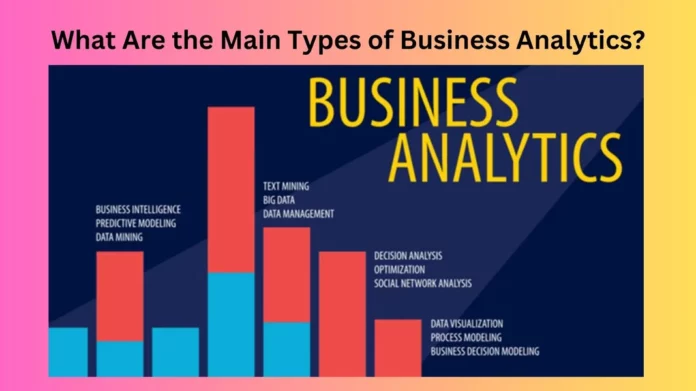In the dynamic landscape of business, harnessing data has become paramount for success. In this article, we delve into the realm of business analytics, exploring its various types and how they can propel your enterprise to new heights.
The Essence of Business Analytics
Understanding the fundamentals
Business analytics is the systematic exploration of an organization’s data to glean insights that drive informed decision-making. It’s the key to unlocking patterns, trends, and correlations that might otherwise go unnoticed.
1: Descriptive Analytics – Painting the Past
Reflecting on historical data
Descriptive analytics involves examining past data to understand what has happened within an organization. It’s akin to painting a portrait of your business’s history, helping you identify strengths, weaknesses, and areas for improvement.
2: Diagnostic Analytics – Unraveling the Whys
Digging deeper into the causes
Moving beyond the surface, diagnostic analytics focuses on uncovering the reasons behind past events. By dissecting data, businesses can pinpoint the root causes of successes and failures, enabling strategic adjustments.
3: Predictive Analytics – Anticipating the Future
Embracing the power of foresight
Predictive analytics is the crystal ball of business. By analyzing historical data and identifying patterns, it forecasts future trends, enabling organizations to prepare for opportunities and challenges that lie ahead.
4: Prescriptive Analytics – Crafting a Path Forward
Optimizing decision-making
Prescriptive analytics goes beyond prediction, offering recommendations on what actions to take to optimize outcomes. It’s the compass guiding businesses toward the most effective strategies based on data-driven insights.
Real-world Applications
Turning theory into action
Now that we’ve explored the types of business analytics, let’s delve into how they manifest in real-world scenarios. From improving operational efficiency to enhancing customer experience, the applications are vast.
1: Enhancing Customer Satisfaction
Utilizing analytics for a customer-centric approach
Business analytics empowers organizations to understand customer behavior, preferences, and feedback. This knowledge allows for personalized interactions, ultimately enhancing customer satisfaction and loyalty.
2: Streamlining Operations
Optimizing efficiency through data-driven decisions
By applying analytics to operational data, businesses can identify bottlenecks, streamline processes, and allocate resources more effectively. This not only enhances efficiency but also reduces costs.
3: Risk Management in the Data Age
Navigating uncertainties with analytics
In an era of constant change, businesses face various risks. Business analytics aids in identifying, assessing, and mitigating these risks, providing a solid foundation for strategic decision-making.
The Human Touch in Analytics
Beyond the numbers
While business analytics relies heavily on data, the human touch is indispensable. It’s not just about algorithms and statistics; it’s about interpreting the insights, understanding the context, and applying a human touch to decision-making.
2: The Role of Intuition
Balancing data and intuition
In the world of business analytics, intuition plays a crucial role. It’s the human element that guides the interpretation of data, ensuring that decisions align with the broader goals and values of the organization.
3: The Need for Effective Communication
Translating insights for action
Analytics professionals must not only be adept at interpreting data but also at effectively communicating their findings to decision-makers. Bridging the gap between analytics and action is where success lies.
Choosing the Right Analytics for Your Business
Tailoring analytics to your needs
Selecting the most suitable type of analytics for your business is paramount. Consider the nature of your data, your industry, and the specific insights you seek to gain. A tailored approach ensures optimal results.
1: Assessing Your Data Landscape
Understanding your data’s potential
Before diving into analytics, assess the nature and quality of your data. A comprehensive understanding of your data landscape lays the groundwork for effective analysis and meaningful insights.
2: Aligning with Organizational Goals
Making analytics an integral part of strategy
Business analytics should align with your organization’s overarching goals. Whether it’s improving customer satisfaction, increasing operational efficiency, or mitigating risks, ensure that analytics serves as a strategic enabler.
3: Embracing a Holistic Approach
Integrating analytics across departments
To maximize the impact of business analytics, foster a culture of data-driven decision-making across all departments. Integration ensures that insights flow seamlessly, driving improvements throughout the organization.
Conclusion: Navigating the Data Frontier
As we conclude our journey through the diverse landscape of business analytics, it’s clear that harnessing the power of data is no longer a luxury but a necessity. By embracing descriptive, diagnostic, predictive, and prescriptive analytics, businesses can not only understand their past and present but also shape a more successful future.
FAQs: Unlocking Insights
1. What skills do I need to leverage business analytics effectively?
- To harness the power of business analytics, proficiency in data analysis tools, statistical knowledge, and a deep understanding of your industry are crucial.
2. How can small businesses benefit from business analytics?
- Small businesses can leverage analytics to gain insights into customer behavior, streamline operations, and make data-driven decisions that contribute to growth.
3. Is it necessary to invest in expensive analytics tools?
- While advanced tools offer robust features, there are also cost-effective analytics solutions suitable for small to medium-sized enterprises, ensuring accessibility for all.
4. Can business analytics be applied to non-profit organizations?
- Absolutely. Non-profits can use business analytics to optimize fundraising efforts, improve operational efficiency, and demonstrate the impact of their initiatives through data.
5. What role does machine learning play in business analytics?
- Machine learning is a subset of business analytics that automates the analysis of large datasets, providing faster and more accurate insights for informed decision-making.















